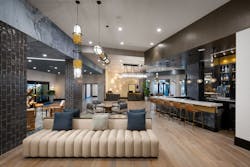Optimizing Performance and Design for the Hospitality Industry
Hotels are a complex building type that demand performance, cleanliness, security and planning precision while delivering a return on investment to the owner/developer and superb guest experiences. Designers must not only understand these core principles and the thoughtful choreography of the “on-stage/off-stage” flow of guests and service, but they must also develop the social, psychological and cultural expertise to deliver comfort and meaningful experiences to the guests and employees that dwell in the spaces they design. The convergence of design, operations and service is what allows these experiences to happen.
Design and Product Selection
With an emphasis on customization of products and services in the hospitality industry, there are performance standards for finishes, furniture and fixtures across all market segments and brands. In addition to having a knowledge of codes and requirements for commercial environments, designers must be well-versed in the standards developed for the hotel brands with whom they work. These are established for the health, safety and welfare of occupants, as well as the longevity of the asset and the brand’s image.
As part of the pre-design process the design team should validate the project standards, program and operational requirements, as well as budget and schedule for delivery of the project, to minimize re-design and reselection of products late in the design or construction process.
The COVID-19 pandemic added a layer of complexity to the design and operation of hotels, including augmented cleaning protocols and the use of healthcare-grade cleaning agents on all surfaces to control the spread of pathogens. In October 2020, the International Well Building Institute (IWBI) developed the WELL Health-Safety Rating established for hotels, resorts and other facilities. This credential, pursued by leading hotel brands such as Loews and Mandarin Oriental, informs guests and employees of evidence-based cleaning and maintenance protocols that have been adopted and verified with third-party document review.
Operators focused on contactless service and surface cleaning, as well as minimizing guest amenities such as remote controls, coffee makers and décor items, to further simplify reduced housekeeping services. The new challenge for hotel designers became infection control and minimalism while maintaining the layers of curated artifacts and personal touches that support the visual narrative expected by guests in leisure environments. Although the pandemic was devastating to the industry, it accelerated innovations in products and technologies as well as environmental and wellness sensibilities in response to new guest and employee expectations.
Standards for Product Performance
There is a baseline for product performance across all hospitality market segments, with an even greater emphasis on performance to withstand more intense use and cleaning protocols. When selecting and specifying materials and products, designers should ask operators about the cleaning agents and protocols being used in their properties and work with manufacturers to develop and increase testing for finishes that are resistant to damage from these chemicals and agents.
Textiles must meet life safety and performance requirements for durability in vertical and horizontal applications. Specifications should also address stain and pathogen resistance as well as acceptable cleaning methods in this new paradigm.
Technologies seen in the healthcare industry for bleach cleanability, antimicrobial treatments and fiber content such as copper and silver ion are now crossing over into development of inspiring patterns and more pliable fabrics with softer “hand” and textures suitable for hospitality environments. Innovations in textile manufacturing from sustainable sources include plant-based, carbon-positive content from bamboo and sugar cane while development continues to increase performance of these organic fibers and an overall cradle-to-cradle approach to manufacturing across the industry.
Manufacturers of casegoods, millwork, seating, flooring and architectural surfaces face similar demands for durability and disinfection, as well as sustainable solutions for their construction and finishing processes. State-of-the-art catalyzed lacquers, powder coated surfaces, resins and two-component polyurethane coatings provide greater resistance to abrasion, corrosion and chemical agents, but designers should still work with manufacturers to verify these products are compatible with the project’s specific cleaning protocols and environmental conditions.
[Related: How to Specify Cleanable Surfaces for Healthcare]
3D printing and digital imaging technologies now enable mass production of unconventional geometries, and non-porous and cleanable surfaces including glass and porcelain can have the optics and texture of natural materials such as wood, marble or unlimited custom graphics. Ultimately, suitcases, chairs, housekeeping and luggage carts, and hand oils are the enemy of the most creative and luxurious hotel environments and should be considered when specifying and detailing surfaces, furniture and touch points.
Lighting has seen some of the most significant evolution of all products in the designer’s toolbox. Decorative lighting is often customized, providing some of the most iconic and creative forms of artistic expression in a project, and new manufacturing technologies are providing access to more complex solutions, effects and finishes in large and small quantities. Innovations in architectural lighting and integrated controls allow adaptive capabilities for accent and ambient light levels and color.
In response to the wellness movement, adaptive lighting capabilities have evolved to be programmable to the body’s circadian rhythms, which has been proven to enhance alertness, sleep, mood and productivity of guests and employees in all environments. Technologies employing specific spectrums of UV lighting have also been found to neutralize pathogens and are able to be integrated into architectural lighting and building systems, however care must be taken to specify the correct spectrum to avoid harm to people using the space.
When specifying lighting, designers must understand these technologies and other attributes such as color temperature, color rendition, tunability and controls, as well as consideration to structural requirements, UL certifications and access. In partnership with manufacturers, lighting designers, architects and engineers, designers can leverage lighting as a major design element for creating dramatic and adaptable environments.
The Future of Products and Hospitality
Delivering service and transformational experiences is the hallmark of the hospitality industry. Savvy guests are informed and demand a level of assurance for cleanliness and sanitation, and health and wellness have come to the forefront of the industry as owners, operators and guests are seeking more environmentally conscious solutions for places where they live, work and play. Global sustainability initiatives now pair with those of WELL Building and Fitwel certifications, promoting not only the health of the planet but those that dwell in it.
Technologies for environmental performance and control such as disinfecting light and HVAC systems as well as smart and touchless device integration are becoming not only mainstream but expected. Strategies that provide personal control of light and temperature, biophilia and ergonomics are at the forefront while products for mood and rest enhancement, fitness and nutrition are part of the guest lifestyle and are being incorporated into the amenities of major brands.
Manufacturers are rising to the occasion to develop products that support these initiatives without sacrificing performance and guest experience. Design professionals can and should be thought leaders in partnership with manufacturers for meaningful integration of products and strategies into their designs, while enjoying the creative freedom that 3D visualization and digital technologies are enabling in customizing products that meet high performance standards for curated luxury environments that inspire and delight.
About the author: Principal of Design for L2 Studios, architect, interior designer and storyteller in her own right, Debra Lemons, AIA, IIDA, WELL+AP, has been shaping the narrative of healthcare and hospitality experiences, with a special emphasis in resorts, hotels, resort sales galleries and themed leisure environments, for more than 27 years.
Read next: How to Specify for the Public Sector
About the Author

firstName lastName
i+s partners with design practitioners and other industry experts to deliver informative and engaging content on a variety of topics related to commercial interior design, from the latest trends, research and technology to innovative projects, products and educational CEUs. Interested in becoming a contributor? Contact us today!
